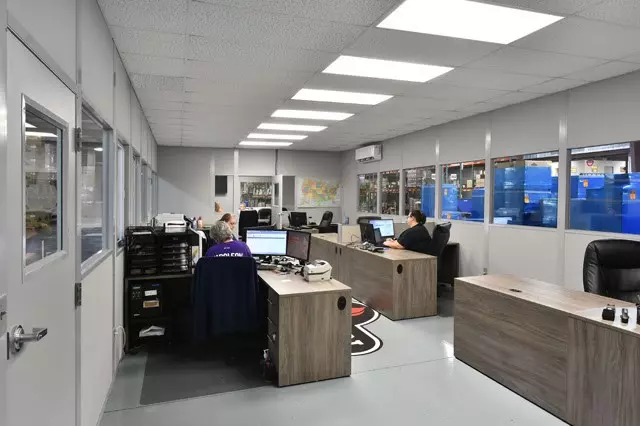


The COVID-19 pandemic has changed the way we look at the workplace. With more people than ever comfortably and effectively working from home, employers and office-space owners are faced with a number of return to work challenges.
How can you prepare your office to become a safe, productive workspace, especially in a time when many companies are tightening their belts? How can you reconfigure your space to accommodate different return-to-work policies like hybrid and staggered approaches? And maybe most importantly, how can you show your employees that all of the work you’re doing is enough to keep them safe?
It’s a significant concern that spans industries and buildings across the nation. Here are 4 return-to-work challenges that modular construction can help you solve:
For most facilities, the initial return-to-work challenge is reconfiguring workspaces to safely separate employees according to the recommended 6-foot distance. In industries and applications where employees must be closer than the 6-foot distance, work indoors in poorly ventilated buildings, or who must remain indoors for longer periods of time, implementing barriers and separation panels is essential.
The challenge is reconfiguring an entire workspace at a time when capital is already tight.
Modular construction provides an affordable, flexible solution to this return-to-work challenge. Not only do modular office panels provide a cost-effective method of reconfiguring your office — install partition walls, half-walls, and more using your office’s existing walls and structure — but they are equally easy to remove and reconfigure as your office or facility needs change.
Design your workspace to suit current requirements, with the knowledge that you have the capability to reconfigure in the future. Modular wall panels and partitions can move as your workspace requirements do, with little hassle for your team and minimal additional expense for your facility.
As mandates begin to lift, employers are looking for ways to bring employees back to the office in ways that work for everyone. To ensure proper spacing and safety, many offices are looking into hybrid and staggered return-to-work approaches that minimize the number of employees in the office at any given time.
Beyond the initial challenge of cost, building owners and office managers are also faced with a challenge of creating spaces that are well-separated, but also simple to clean.
Most office and facility managers are already working to accommodate these needs by eliminating “assigned” or dedicated seating for each employee. Clearing desks of personal items and enabling a “sit anywhere” layout makes it easy for those employees who are returning to distance safely. This also makes cleaning much easier, as employees and janitorial staff can simply wipe down these clutter-free spaces at the end of the day to ensure the space is disinfected for the next user.
As you implement separation panels and barriers to create the necessary space, it’s a good idea to choose panels that are easy to wipe down and disinfect.
This is where modular construction comes in — many modular wall panels are made of solid, durable, and easy-to-clean materials with water-resistant finishes that are non-porous and easy to wipe down. This helps ensure that germs aren’t lingering in shared workspaces, and makes it easier for employees and janitorial staff to ensure they’re following cleaning protocol to the letter.
Many workspaces are turning to a “pod” or small team mode of operation to ensure work still gets done, while minimizing employee’s exposure. The theory here is that employees are in contact with a smaller number of coworkers, minimizing their potential to contract the virus, and minimizing the impact on the company should one person be exposed.
This is a smart way to bring employees back into the office, and modular construction methods can provide solutions to ensure that adopting a pod mentality isn’t a challenge.
Modular wall panels, half-walls, and partitions easily accommodate this kind of collaboration by creating smaller, well-ventilated spaces where these teams can work together safely. For an example of how modular construction is already working to support applications like these, we encourage you to look into Starrco’s conference room enclosure solutions.
As one Business Insider article noted, the most difficult challenge for any employer starting the return-to-work process will be convincing employees to come back. Not only has work from home become the comfortable norm — it’s also where employees feel safest.
Creating a clean, comfortable space that your employees are excited and feel safe returning to is the greatest challenge you’ll face in the return-to-work process. One great solution that modular construction can provide is tangible evidence that you are working hard to create that safe space for returning employees.
It’s one thing to say you’re upping your cleaning protocol. It’s another to reconfigure the office in a way that implements safely partitioned workspaces clearly set apart at a distance of six feet or greater.
The implementation of physical items like separation panels, modular walls, smaller conference rooms, visual barriers, and more, is a safety protocol your employees can see and touch. When your employees have a tangible representation of the changes you’re making, it will be easier for them to understand exactly how you’re working to create that cleaner environment for them to return to work safely.
That’s one key reason why modular construction is so essential to your return-to-work process. Modular building components provide the simple, efficient solution to your greatest return-to-work challenge, by providing those safe barriers in a way that’s both attractive and cost-effective for your company.
The return-to-work process following COVID-19 will be slow. The better able you are to show your employees that you’re working on their behalf, the faster and easier you can make that transition. If you’re beginning the return-to-work process and just aren’t sure where to start, Starrco can help. Make sure your team has everything they need to get back to work safely and productively with affordable, flexible modular construction solutions from the experts at Starrco.